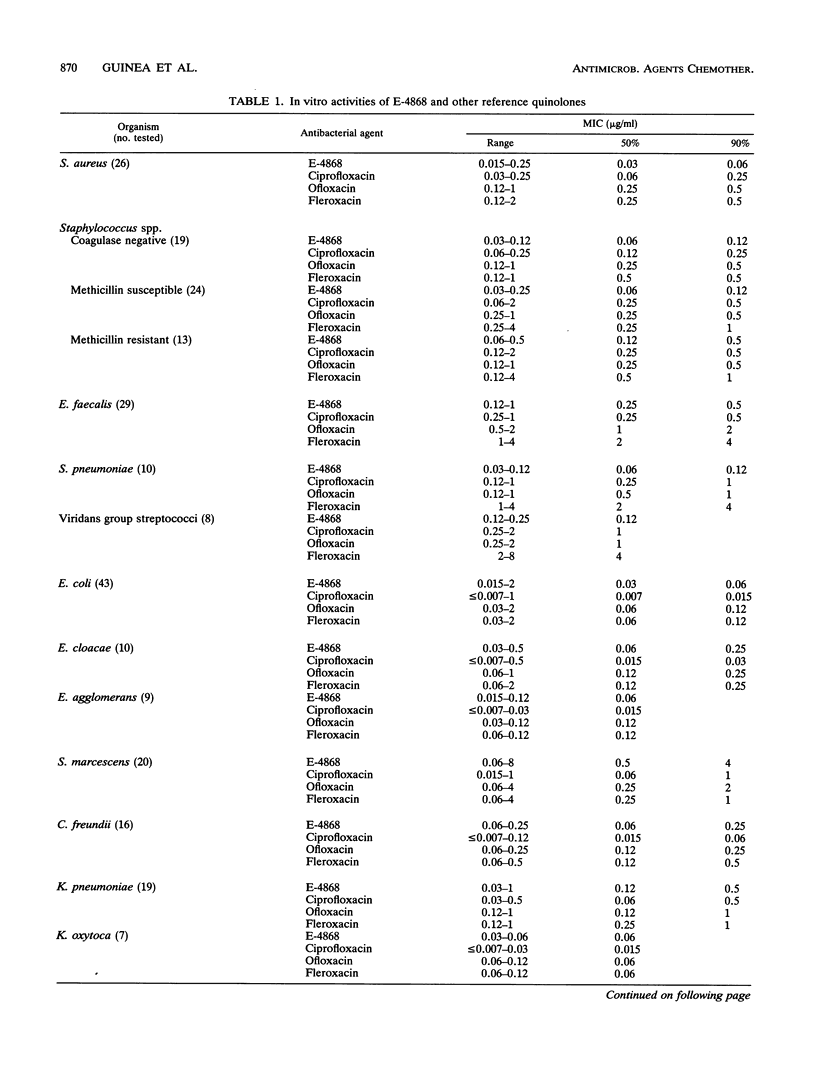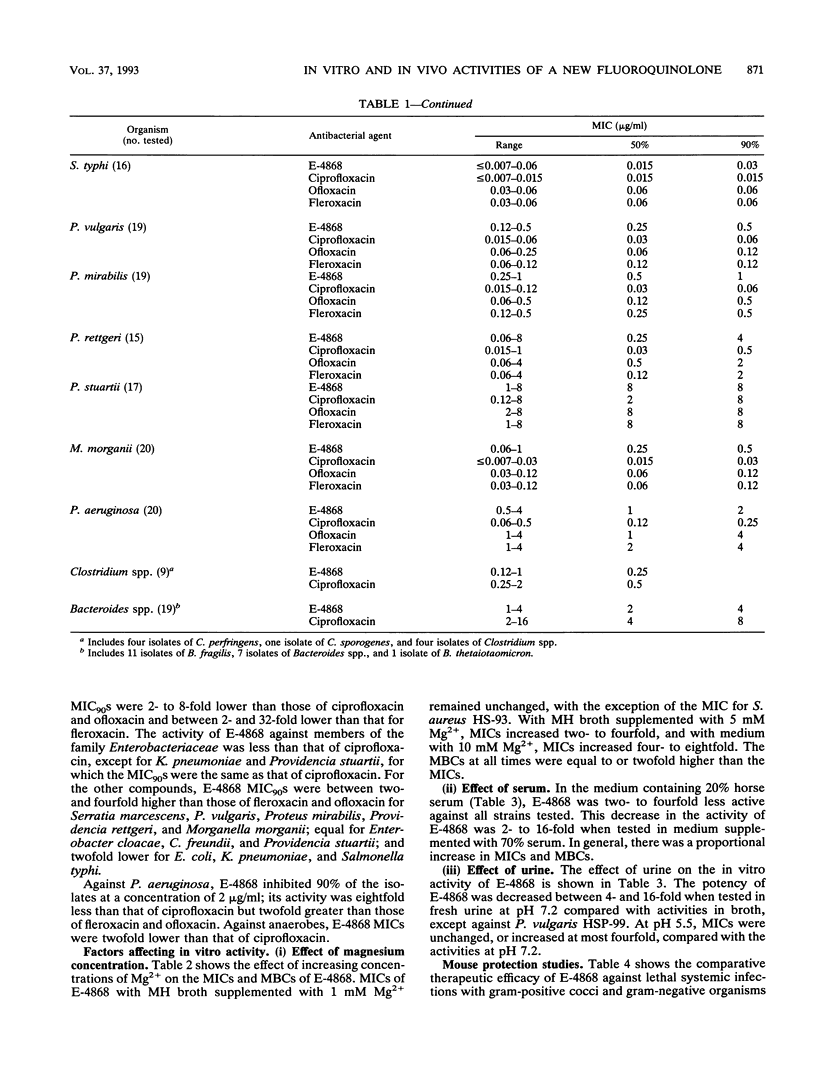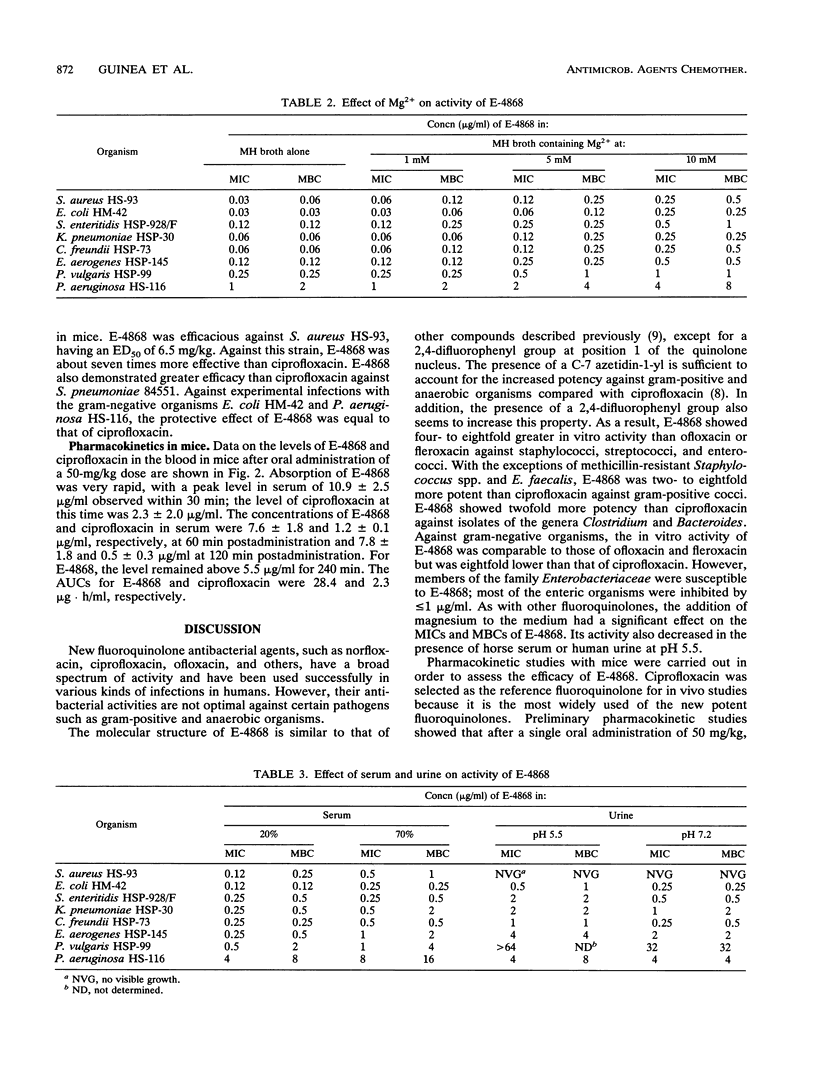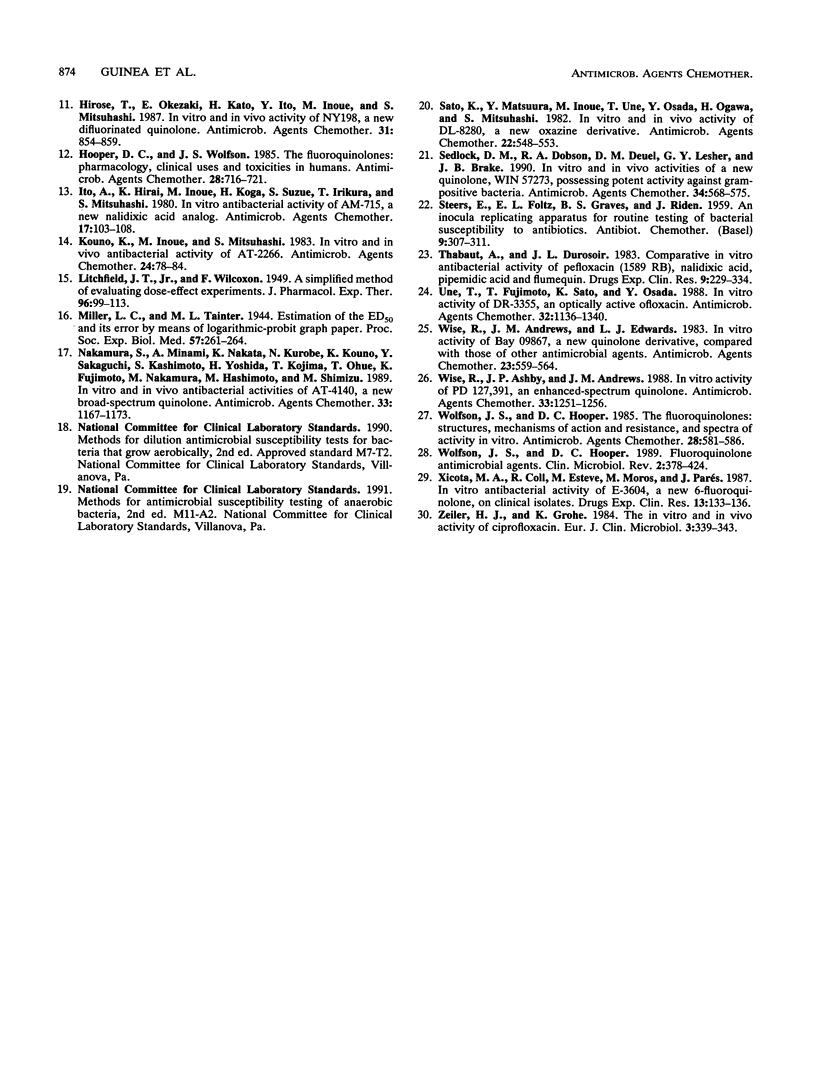Abstract
E-4868, (-)-7-[3-(R)-amino-2-(S)-methyl-1-azetidinyl]-1-(2,4- difluorophenyl)-1,4-dihydro-6-fluoro-4-oxo-3-quinolinecarboxylic acid, is a new fluoroquinolone with an azetidine moiety at the 7 position. The in vitro activity of E-4868 has been compared with those of ciprofloxacin, ofloxacin, and fleroxacin, while the activity of ciprofloxacin was used as reference for in vivo studies. The MICs of E-4868 for 90% of the isolates tested (MIC90s) were 0.06 to 0.5 microgram/ml against gram-positive organisms, including Staphylococcus, Streptococcus, and Enterococcus spp. In general, the in vitro potency of E-4868 against gram-positive bacteria was higher than those of all of the other fluoroquinolones tested. MIC90s against members of the family Enterobacteriaceae between 0.03 and 1 microgram/ml were observed, with the exception of those against Serratia marcescens and Providencia spp., and a MIC90 of 2 micrograms/ml against Pseudomonas aeruginosa was obtained. E-4868 inhibited 90% of the Clostridium spp. and Bacteroides spp. at 2 micrograms/ml and was twofold more active than ciprofloxacin. An increase in the Mg2+ concentration from 1 to 10 mM increased the MIC between two and three times. Human urine caused a significant decrease in activity of E-4868, which was more pronounced at pH 5.5 than at pH 7.2. The presence of serum also decreased the activity of E-4868. Fifty percent effective dose (ED50) values against experimental Escherichia coli HM-42 infections in mice were 3.9 mg/kg of body weight with E-4868 and 3.5 mg/kg of body weight with ciprofloxacin. Corresponding ED50 values against P. aeruginosa HS-116 were 93.2 and 107.8 mg/kg, respectively, and those against Staphylococcus aureus HS-93 were 6.5 and 44.6 mg/kg, respectively. In experimental infections with Streptococcus pneumoniae 84551, the ED50 value of E-4868 was 154.4 mg/kg, while ciprofloxacin proved totally inactive at a dose of 400 mg/kg. When E-4868 was administered orally at a dose of 50 mg/kg in mice, the area under the concentration-time curve (0 to 4 h) value was 28.4 microgram . h/ml, while an area under the concentration-time curve value of 2.3 microgram . h/ml was observed for ciprofloxacin at the same dose. In these studies, levels of the two agents in blood 1 h postadministration were 7.6 and 1.2 microgram/ml, respectively.
Full text
PDF






Selected References
These references are in PubMed. This may not be the complete list of references from this article.
- Chin N. X., Brittain D. C., Neu H. C. In vitro activity of Ro 23-6240, a new fluorinated 4-quinolone. Antimicrob Agents Chemother. 1986 Apr;29(4):675–680. doi: 10.1128/aac.29.4.675. [DOI] [PMC free article] [PubMed] [Google Scholar]
- Chu D. T., Fernandes P. B. Structure-activity relationships of the fluoroquinolones. Antimicrob Agents Chemother. 1989 Feb;33(2):131–135. doi: 10.1128/aac.33.2.131. [DOI] [PMC free article] [PubMed] [Google Scholar]
- Coll R., Esteve M., Moros M., Xicota M. A., Parés J. In vitro antibacterial activity of irloxacin (E-3432) on clinical isolates. Drugs Exp Clin Res. 1987;13(2):75–77. [PubMed] [Google Scholar]
- Cornett J. B., Wagner R. B., Dobson R. A., Wentland M. P., Bailey D. M. In vitro and in vivo antibacterial activities of the fluoroquinolone WIN 49375 (amifloxacin). Antimicrob Agents Chemother. 1985 Jan;27(1):4–10. doi: 10.1128/aac.27.1.4. [DOI] [PMC free article] [PubMed] [Google Scholar]
- Fernandes P. B., Chu D. T., Swanson R. N., Ramer N. R., Hanson C. W., Bower R. R., Stamm J. M., Hardy D. J. A-61827 (A-60969), a new fluoronaphthyridine with activity against both aerobic and anaerobic bacteria. Antimicrob Agents Chemother. 1988 Jan;32(1):27–32. doi: 10.1128/aac.32.1.27. [DOI] [PMC free article] [PubMed] [Google Scholar]
- Fung-Tomc J., Desiderio J. V., Tsai Y. H., Warr G., Kessler R. E. In vitro and in vivo antibacterial activities of BMY 40062, a new fluoronaphthyridone. Antimicrob Agents Chemother. 1989 Jun;33(6):906–914. doi: 10.1128/aac.33.6.906. [DOI] [PMC free article] [PubMed] [Google Scholar]
- Gargallo-Viola D., Esteve M., Llovera S., Roca X., Guinea J. In vitro and in vivo antibacterial activities of E-4497, a new 3-amine-3-methyl-azetidinyl tricyclic fluoroquinolone. Antimicrob Agents Chemother. 1991 Mar;35(3):442–447. doi: 10.1128/aac.35.3.442. [DOI] [PMC free article] [PubMed] [Google Scholar]
- Gargallo-Viola D., Esteve M., Moros M., Coll R., Xicota M. A., de Andres C., Roser R., Guinea J. Comparative in vitro and in vivo activities of six new monofluoroquinolone and difluoroquinolone 3-carboxylic acids with a 7-azetidin ring substituent. Antimicrob Agents Chemother. 1990 Dec;34(12):2318–2326. doi: 10.1128/aac.34.12.2318. [DOI] [PMC free article] [PubMed] [Google Scholar]
- Gargallo D., Moros M., Coll R., Esteve M., Parés J., Xicota M. A., Guinea J. Activity of E-3846, a new fluoroquinolone, in vitro and in experimental cystitis and pyelonephritis in rats. Antimicrob Agents Chemother. 1988 May;32(5):636–641. doi: 10.1128/aac.32.5.636. [DOI] [PMC free article] [PubMed] [Google Scholar]
- Hardy D. J., Swanson R. N., Hensey D. M., Ramer N. R., Bower R. R., Hanson C. W., Chu D. T., Fernandes P. B. Comparative antibacterial activities of temafloxacin hydrochloride (A-62254) and two reference fluoroquinolones. Antimicrob Agents Chemother. 1987 Nov;31(11):1768–1774. doi: 10.1128/aac.31.11.1768. [DOI] [PMC free article] [PubMed] [Google Scholar]
- Hirose T., Okezaki E., Kato H., Ito Y., Inoue M., Mitsuhashi S. In vitro and in vivo activity of NY-198, a new difluorinated quinolone. Antimicrob Agents Chemother. 1987 Jun;31(6):854–859. doi: 10.1128/aac.31.6.854. [DOI] [PMC free article] [PubMed] [Google Scholar]
- Hooper D. C., Wolfson J. S. The fluoroquinolones: pharmacology, clinical uses, and toxicities in humans. Antimicrob Agents Chemother. 1985 Nov;28(5):716–721. doi: 10.1128/aac.28.5.716. [DOI] [PMC free article] [PubMed] [Google Scholar]
- Ito A., Hirai K., Inoue M., Koga H., Suzue S., Irikura T., Mitsuhashi S. In vitro antibacterial activity of AM-715, a new nalidixic acid analog. Antimicrob Agents Chemother. 1980 Feb;17(2):103–108. doi: 10.1128/aac.17.2.103. [DOI] [PMC free article] [PubMed] [Google Scholar]
- Kouno K., Inoue M., Mitsuhashi S. In vitro and in vivo antibacterial activity of AT-2266. Antimicrob Agents Chemother. 1983 Jul;24(1):78–84. doi: 10.1128/aac.24.1.78. [DOI] [PMC free article] [PubMed] [Google Scholar]
- Nakamura S., Minami A., Nakata K., Kurobe N., Kouno K., Sakaguchi Y., Kashimoto S., Yoshida H., Kojima T., Ohue T. In vitro and in vivo antibacterial activities of AT-4140, a new broad-spectrum quinolone. Antimicrob Agents Chemother. 1989 Aug;33(8):1167–1173. doi: 10.1128/aac.33.8.1167. [DOI] [PMC free article] [PubMed] [Google Scholar]
- Sato K., Matsuura Y., Inoue M., Une T., Osada Y., Ogawa H., Mitsuhashi S. In vitro and in vivo activity of DL-8280, a new oxazine derivative. Antimicrob Agents Chemother. 1982 Oct;22(4):548–553. doi: 10.1128/aac.22.4.548. [DOI] [PMC free article] [PubMed] [Google Scholar]
- Sedlock D. M., Dobson R. A., Deuel D. M., Lesher G. Y., Rake J. B. In vitro and in vivo activities of a new quinolone, WIN 57273, possessing potent activity against gram-positive bacteria. Antimicrob Agents Chemother. 1990 Apr;34(4):568–575. doi: 10.1128/aac.34.4.568. [DOI] [PMC free article] [PubMed] [Google Scholar]
- Une T., Fujimoto T., Sato K., Osada Y. In vitro activity of DR-3355, an optically active ofloxacin. Antimicrob Agents Chemother. 1988 Sep;32(9):1336–1340. doi: 10.1128/aac.32.9.1336. [DOI] [PMC free article] [PubMed] [Google Scholar]
- Wise R., Andrews J. M., Edwards L. J. In vitro activity of Bay 09867, a new quinoline derivative, compared with those of other antimicrobial agents. Antimicrob Agents Chemother. 1983 Apr;23(4):559–564. doi: 10.1128/aac.23.4.559. [DOI] [PMC free article] [PubMed] [Google Scholar]
- Wise R., Ashby J. P., Andrews J. M. In vitro activity of PD 127,391, an enhanced-spectrum quinolone. Antimicrob Agents Chemother. 1988 Aug;32(8):1251–1256. doi: 10.1128/aac.32.8.1251. [DOI] [PMC free article] [PubMed] [Google Scholar]
- Wolfson J. S., Hooper D. C. Fluoroquinolone antimicrobial agents. Clin Microbiol Rev. 1989 Oct;2(4):378–424. doi: 10.1128/cmr.2.4.378. [DOI] [PMC free article] [PubMed] [Google Scholar]
- Wolfson J. S., Hooper D. C. The fluoroquinolones: structures, mechanisms of action and resistance, and spectra of activity in vitro. Antimicrob Agents Chemother. 1985 Oct;28(4):581–586. doi: 10.1128/aac.28.4.581. [DOI] [PMC free article] [PubMed] [Google Scholar]
- Xicota M. A., Coll R., Esteve M., Moros M., Parés J. In vitro antibacterial activity of E-3604, a new 6-fluoroquinolone, on clinical isolates. Drugs Exp Clin Res. 1987;13(3):133–136. [PubMed] [Google Scholar]
- Zeiler H. J., Grohe K. The in vitro and in vivo activity of ciprofloxacin. Eur J Clin Microbiol. 1984 Aug;3(4):339–343. doi: 10.1007/BF01977490. [DOI] [PubMed] [Google Scholar]


